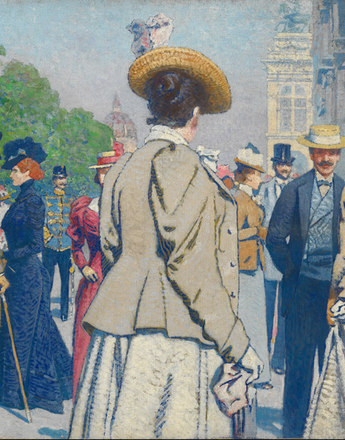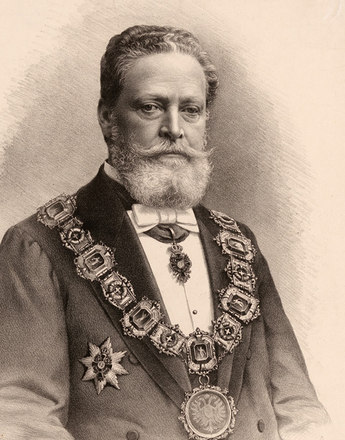The beginnings of the Christian Social Party are to be found firstly in the Catholic Social Reform movement of a certain Freiherr Karl von Vogelsang, and secondly, in the Vienna small trades movement, whose aim was to maintain the competitiveness of small businesses against large-scale industry.
Taking Christian ideas as his basis, Karl von Vogelsang proposed solving the social question within the Habsburg Monarchy through the creation of a corporative social structure. His objective was a protectionist economic system, fair wages and general suffrage. The power of capitalism was to be undermined, the differences between the classes eliminated and replaced by cooperative principles. Vogelsang's ideas found support among both the high aristocracy – for instance Prince Aloys Liechtenstein – and the clergy – Msgr. Josef Scheicher and Franz Martin Schindler – and had a major influence on the later organisers of the Christian Social movement – Ernst Schneider, Albert Gessman and Karl Lueger.
Although Vogelsang worked for the Vienna Vaterland newspaper, his social reform approaches initially had little impact.
It was only once Karl Lueger joined the Christian Social movement that it developed into a popular movement and a modern mass party. Lueger, a lawyer of middle class origins, was a talented speaker, populist and passionate suburban politician. He began his political career with the Liberals, but soon abandoned liberalism. As one of its main opponents, he finally became the representative of artisans and small businesses, whose very existence was threatened by the economic crisis and the start of industrial mass production. Lueger made contacts with the Austrian Reform Association, and was attracted by its anti-Semitic ideology. Finally, he made contact with Vogelsang and the Christian Social Association founded in 1887.
The anti-liberal and anti-Semitic groups joined to create the alliance of the United Christians at the end of the 1880s. Alongside trade reformers and the supporters of the Christian social movement, it also attracted members of the democratic, conservative Catholic and German National movements. After Georg von Schönerer's departure, Karl Lueger was able to establish himself as its leader. However, the name of the alliance was not related to a common Christian ideology and instead, following the centuries-old Christian-Jewish dichotomy, it served as a collective name for all anti-Semites. Its lack of homogeneity led to the association being nicknamed the "Sausage Pot Party".
Alongside the protection of the peasantry and artisans, the United Christians pushed for fiscal reform and the creation of a cooperative system. In addition, they demanded the exclusion of Jews from the ownership of land, from the civil service, the judiciary, the higher ranks of the army, the legal and medical professions, the trade in food and public teaching. Christian Social policies initially covered the interests of the anti-liberal Viennese artisans and civil servants and can be regarded as neither Christian nor social. Gradually, however, the movement became Christianised.
Its leaders met weekly in the restaurant "Zur goldenen Ente" ("The Golden Duck"), where, at what were known as "duck evenings", they would debate the Catholic social reform movement and the solution to the "social question". These "duck evenings" were, in the words of Klaus Berthold, the actual "Christian Socials' party academy".
Translation: David Wright
Buchmann, Bertrand Michael: Kaisertum und Doppelmonarchie, Wien 2003
Berchtold, Klaus: Österreichische Parteiprogramme 1868-1966, Wien 1967
Bruckmüller, Ernst: Sozial-Geschichte Österreichs, 2. Auflage, Wien/München 2001
Hanisch, Ernst/Urbanitsch, Peter: Grundlagen und Anfänge des Vereinswesens, der Parteien und Verbände in der Habsburgermonarchie, in: Rumpler, Helmut/Urbanitsch, Peter (Hrsg.): Die Habsburgermonarchie 1848-1918. Bd. VIII. Politische Öffentlichkeit und Zivilgesellschaft. 1. Teilband. Vereine, Parteien und Interessenverbände als Träger der politischen Partizipation, Wien 2006, 15-111
Kriechbaumer, Robert: Die großen Erzählungen der Politik. Politische Kultur und Parteien in Österreich von der Jahrhundertwende bis 1945, Wien/Köln/Weimar 2001
Loinig, Elisabeth: Revolution – Reaktion – Massenparteien. Politik, Verfassung und Verwaltung in Niederösterreich 1848-1896, in: Eminger, Stefan/Loinig, Elisabeth/Rosner, Willibald (Hrsg.): Ein Land im Zeitraffer. Niederösterreich seit 1848, St. Pölten 2012, 17-35
Rumpler, Helmut: Österreichische Geschichte 1804-1914. Eine Chance für Mitteleuropa. Bürgerliche Emanzipation und Staatsverfall in der Habsburgermonarchie, Wien 1997
Urbanitsch, Peter: Politisierung der Massen, in: Das Zeitalter Kaiser Franz Josephs. 2. Teil 1880-1916. Glanz und Elend (Ausstellungskatalog der Niederösterreichischen Landesausstellung im Schloss Grafenegg), Wien 1987, 106-118
Vocelka, Karl: Karikaturen und Karikaturen zum Zeitalter Kaiser Franz Josephs, Wien 1986
Vocelka, Karl: Geschichte Österreichs. Kultur – Gesellschaft – Politik, 3. Auflage, Graz/Wien/Köln 2002
Wandruszka, Adam: Österreichs politische Struktur. Die Entwicklung der Parteien und politischen Bewegungen, in: Benedikt, Heinrich (Hrsg.): Geschichte der Republik Österreich, Wien 1977, 289-486
Quotes:
"Christian Socials' party academy": Berchtold, Klaus: Österreichische Parteiprogramme 1868-1966, Wien 1967, 50 (Translation)
-
Chapters
- Preconditions and beginnings of political participation
- On the road to political participation
- Liberalism and conservatism
- The rise and fall of liberalism
- Workers unite!
- Party of the masses
- Between a truce policy and left-wing radicalism
- Karl Lueger and the "Sausage Pot Party"
- "The Colossus of Vienna"
- Rise and fall
- Commitment to the Monarchy
- "Greater German", "Smaller German" or "German National"?
- "German and loyal, outright and true"
- "Prussian plestilence" or Habsburgophilia
- The battle for the 'national electorate'




